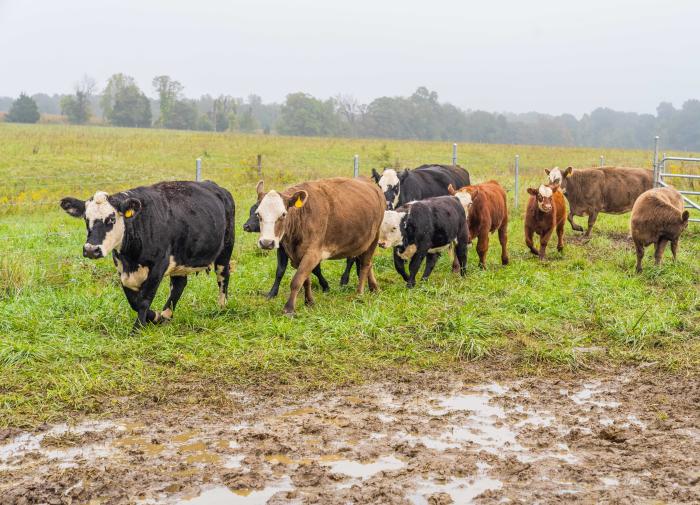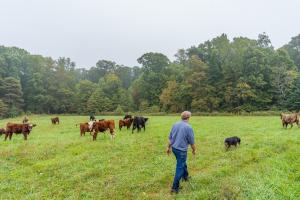Generational Farm in Indiana Brings Water Closer to Cows

Jerry Bates enlisted the help of NRCS to design a system to provide water to his cows throughout the farm his family has owned since the 1920s
By Brandon O'Connor, Public Affairs Specialist, USDA-NRCS, Indianapolis
It takes almost no effort. As Jerry Bates swings open the gate in the fence, the cows do the rest of the work without any prodding, leaving behind their watering facility and the field they’d been grazing for the last few days and heading toward a fresh field of grass.
Bates has 30 head of beef cattle, plus about 20 calves born this year, divided between two farms, but the largest portion of the herd lives on a 209-acre property in Cloverdale, Indiana where he is working this morning. As he swings open the gate that subdivides grazing areas, a mix of heifers, calves and a single bull file through in a bunched line before scattering across the few acre field to begin grazing.

Bates has owned the plot of land, which is evenly divided between forest and grassland, since 2010, but it has been in his family since his grandfather bought it in 1924. Bates’ grandfather was raised on an 80-acre farm about seven miles away where Bates now lives and raises the rest of his herd.
Attracted to the white oaks that dotted the property and with a plan to raise pigs, Bates’ grandfather attended an auction where the 209 acres were up for bid. Luck was on his side that day as he was the only person to attend the auction and he was able to purchase the land for a couple thousand dollars or about the price of a Buick at the time, as Bates tells it.
The acres weren’t prime farmland, but there were blackberries for Bates’ mom and grandmother to pick and land for the pigs to graze as Bate’s grandfather set about building his pig farm.
“At that time, there was no roof on the barn. Everything was ravines with erosion everywhere. It was farmed out. There was nothing left anywhere. All the fields were either full of saplings or blackberries,” Bates said. “When he bought it, nobody had a tractor. It was just all hard work and maybe some horses.”
Pigs remained the main residents of the property until the mid-1900s when cholera hit the area, decimating the pig farms and making it impossible to raise them for years to come. It was then that Bates’ grandfather switched to cattle. The size of the herd has fluctuated over the years, but cattle have had a constant presence on the farm ever since they were first raised by Bates’ grandfather, then his uncle and now Bates himself.

Although he grew up in suburban Illinois, many of Bates’ fondest childhood memories took place on the farm he now calls home, and it was those memories that eventually pulled him there permanently. As a young child he would travel to Indiana with his mom and spend summers helping his grandfather and uncle tend to the cattle. Then, as he got older, she would leave him there by himself to work away the long summer days painting fences, mowing, cutting lumber and doing any tasks his grandfather and uncle needed done.
During high school, and for a stretch afterward, his path would take him away from the farm, but after attending art school in Colorado for a couple years he decided to put down roots in Indianapolis to be near the farm. His path would eventually take him away again, first to school in New York, then traveling around the world with his wife, Katie, and their bicycles for a couple years and eventually to New Zealand and Australia where they worked as farm hands on organic farms with an eye toward returning to Indiana and joining the family farm.
They eventually left the road behind and made the permanent move to Cloverdale in 1997 where they began building a family and their own cattle herd on the 80 acres originally owned by Bates’s great-grandfather.
“We landed on our farm and there was nothing there,” Bates said. “There was an old home that an arsonist burned down, like 10 years before we moved back. So, we pulled the trailer in and just kind of got started.”

They started building a house and Bates did work for his uncle in return for six heifers. He also began marketing his uncle’s calves as they slowly built Bates Family Farm from scratch. He eventually took over operation of his uncle’s herd and bought the entire operation in 2010 from his aunt following his uncle’s passing in 2008.
Much like when his grandfather bought the land in the 1920s, Bates acquired it at a time when it needed improvements. The herd was down to 18 at the time, but in the decade since Bates, his wife and their two sons, Abel and Ray, have worked to grow it to the 30 head of cattle that now call the two farms home. Along with the need to rebuild the herd, Bates was faced with a myriad of challenges in the actual operation of the cattle farm.
Bates’ uncle had enrolled 60 of the 209 acres into a 100-year grassland easement which provided ample grazing area, but the cattle had limited access to water and no fencing to control where they roamed and grazed.
Each day, they would have to make their way from the farthest fields almost back to barn, about a 20-minute walk for Bates, to drink from the creek which was their only water source. This created cesspools in shaded areas where they would congregate, polluted the creek with their waste as they stood there and drank, and prevented grass in high traffic areas to ever rest and regenerate.
That began to change in 2018 thanks to a call from the district conservationist working for USDA’s Natural Resources Conservation Service (NRCS) in his county. The grassland easement his grandfather had enrolled a portion of his property in required periodic check-ins, so when the district conservationist called and asked how the easement was going, Bates took the opportunity to explain his issues.
“So (the district conservationist) called me up and said how's it going with your grassland reserve,” Bates recalled. “I said pretty good, but you know, it's just not working out that great because the cattle are eating the grass and are going down the creek and (releasing waste) and it's all going down to the Lieber (State Recreation Area). If you go swim at Lieber, you see moss going over it because it's got too much nitrogen from runoff. This goes right there, so I know I'm one of the culprits.”

From that initial phone conversation, Bates started a multi-year process with NRCS that transformed his property for good. They started by developing a conservation plan that included the installation of fences to keep the cows from entering the creek and to subdivide his pastures, which allows for rotational grazing.
They also designed an alternative system to provide water for the cattle including a watering facility at the barn and three tire tank watering facilities throughout the grazing pastures. With the fences and watering facilities paired together, the cows now have access to fresh clean water without traveling long distances to the creek and Bates can control where they are grazing. By rotating the cows from field to field, the grass now has time to rest and regenerate without ever being completely decimated by grazing animals. Ideally, Bates said, they will only return to each field every 45 days after the grass has had time to fully regrow.
After working with his district conservationist to design a conservation plan, Bates applied for and received funding through NRCS’ Environmental Quality Incentives Program (EQIP) which provides funding to farmers to address resources concerns related to water quality and soil health. In Bates’ case, EQIP helped cover a large portion of the cost as he installed 3,000 feet of fencing, 7,000 feet of water line and four watering facilities. EQIP also helped cover the cost of installing a heavy use area protection (HUAP) pad outside of his barn where he can bed the cows during the winter without having to worry about nutrient and pathogen loss from manure into the surface and ground water.
Bates said he has seen an immediate impact not just on his land, but also on the health of the cows in the four years since the fences, water facilities and HUAP were installed. The cows now have better food sources because the grass is regenerating, access to clean water and they aren’t spending entire days wallowing in cesspools they’ve created. Keeping the cows in the field and out of the creek also enables them to better fertilize the fields with their waste, creating a cyclical system where they are helping to regenerate their future food supply.
“It's been quite a transition,” said Thomas Perkins, the current district conservation for Owen County. “I definitely see places where they were in the creek. When we were working on the pipeline we went down there and it was kind of a mess. Now, it's a night and day difference where we looked at today.”
It is a transition Bates said would not have been possible without the technical and financial assistance provided by NRCS through EQIP. Although he did much of the work himself, NRCS experts designed the entire system including plans on how to build the watering facilities, laying the water line and how to rotationally graze the cattle throughout the fields.
“(The technical assistance) was great for the water systems,” Bates said. “I knew zero about it and they had really great plans. The tire tanks, I'd never even heard of them. Putting them in, (the NRCS) had detailed drawings on how to plumb them in there and a list of sources on where to get things.
He has recently started using temporary electric fencing which allows him to even further subdivide the seven grazing areas created by the permanent fencing. His goal is to eventually allow each area to rest for 60 days before cattle return and to cut down on the amount of hay he uses to supplement their diet.
He also recently signed up for a second EQIP contract to address resource concerns on the 80-acre farm where he and the rest of the herd live. Over the next few years, the new contract will help him install a pumping plant and watering facilities on that property, as well as address resource concerns in a swampy bottom the cows currently use as a drinking water source.
“It's been a great program for incentivizing you to really create a better environment for your cattle, and one that's going to last for a while,” Bates said.
Additional Information
Environmental Quality Incentives Program - Indiana
The Environmental Quality Incentives Program (EQIP) provides financial and technical assistance to agricultural producers and non-industrial forest managers to conserve natural resources while strengthening their operations.
Learn MoreINDIANA PASTURE MANAGEMENT
When it comes to improving your pastureland, good management and the right conservation practices makes it possible to have lush, green pastures, clean water, and healthy animals. NRCS can help you achieve these goals with financial and technical assistance.
INDIANA NRCS HOMEPAGE
For more information about NRCS programs offered in Indiana and how experts throughout the state can help you address natural resource concerns on your land, visit the Indiana NRCS homepage.

